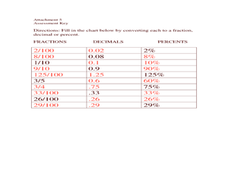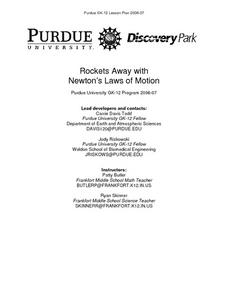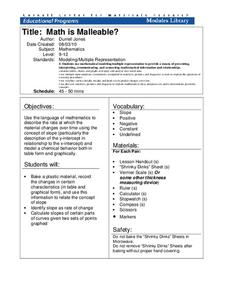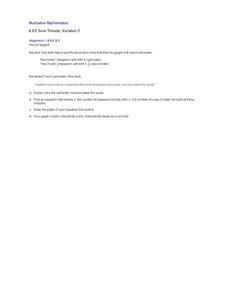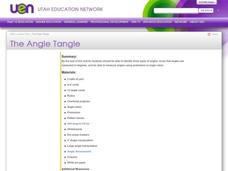Curated OER
Convert among decimals, fractions, and percents
Seventh graders convert among decimals, percents, and fraction with and without a calculator. In this seventh grade mathematics lesson plan, 7th graders explore strategies that help them to remember how to perform the needed operation...
Curated OER
Sliders - Static and Kinetic Friction
Learners work in groups to conduct experiments the demonstrate the differences between static and kinetic friction. They consider how friction affects us in our everyday lives, determine the effects of weight on friction and complete a...
Curated OER
The Exchange, Destruction and Reconstruction of Architectural Signs and Symbols in Mexico-Tenochtitlan: A History of Order and Power
Fifth graders use the internet to research the history of cultures throughout the world. In groups, they disucss the meaning of various symbols and view Tenochtitlan as a center of power and wealth. They use everyday materials to...
Curated OER
Symmetry
Third graders find symmetry in nature. In this symmetry lesson, 3rd graders discover that symmetry is in nature and our everyday world. Students examine the alphabet for symmetrical letters then create their own artwork showing symmetry.
Curated OER
Rockets Away with Newton's Laws of Motion
Eighth graders comprehend Newton's Laws of Motion and to use the scientific method in rocketry sub-unit. They work through the scientific method. Students illustrate how science and Newton's Laws can be used in everyday situations and...
Curated OER
Move My Way: A CBR Analysis of Rates of Change
Learners match a given velocity graph and sketch the corresponding position graph using a graphing calculator. After collecting data from their everyday life, students use specific functions on their calculators to create graphs and...
Curated OER
Rice Math
Sixth graders calculate the amount of rice there will be if the amount is doubled everyday. In this multiplying lesson, 6th graders are given an amount of rice that is grown each day. Students then calculate how much rice there will be...
Cornell University
Math Is Malleable?
Learn about polymers while playing with shrinky dinks. Young scholars create a shrinky dink design, bake it, and then record the area, volume, and thickness over time. They model the data using a graph and highlight the key features of...
Berkshire Museum
Reduce, Reuse, and Recycle: Sorting Through Personal Choices
Raise children's awareness about the importance of conservation with this hands-on science lesson. Start by breaking the class into groups and having them collect trash from around the school or local park. Students then use the provided...
Illustrative Mathematics
The Florist Shop
A real-world approach to common multiples asks learners to find different groups of flowers based on their multiples. Useable as a class activity or independent exercise, they will have to organize their thoughts to explain the totals of...
Illustrative Mathematics
Sore Throats, Variation 2
What does math have to do with a sore throat? When you mix water and salt you have a great review of how to represent proportional relationships by an equation or graph. Here the proportions of the mixtures may be different, but the...
Illustrative Mathematics
Writing Constraints
Use this resource to present your number crunchers with how to write a constraint equation and to determine viable solutions. The price of an object limits the amount that can be purchased. The speed at which you walk limits the number...
Virginia Department of Education
Thermochemistry: Heat and Chemical Changes
What makes particles attract? Here, learners engage in multiple activities that fully describe colligative properties and allow the ability to critically assess the importance of these properties in daily life. Young chemists conduct...
Curated OER
Blazing the Trail
Learning about proportions through measuring and mapping distances is the focus of this real-world math lesson that doubles as an activity. Mathematicians complete a course designed to measure and map locations in order to put the...
EngageNY
Describing the Center of a Distribution Using the Median
Find the point that splits the data. The lesson presents to scholars the definition of the median through a teacher-led discussion. The pupils use data lists and dot plots to determine the median in sets with even and odd number of data...
EngageNY
Modeling from a Sequence
Building upon previous knowledge of sequences, collaborative pairs analyze sequences to determine the type and to make predictions of future terms. The exercises build through arithmetic and geometric sequences before introducing...
EngageNY
Choice of Unit
Explore using units with scientific notation to communicate numbers effectively. Individuals choose appropriate units to express numbers in a real-life situation. For this 13th lesson of 15, participants convert numbers in scientific...
Curated OER
Budget Mania
Students examine several examples of budgets to develop a facility with the components of its formation. Income, expenses, and expenditures are considered and itemized for this lesson.
Curated OER
Budget Mania
Students examine examples of budgets and explore the difficulties of living on a budget. The hands-on activity offers an opportunity to experience a real life application.
Curated OER
Probability
Sixth graders explore theoretical and experimental probability. In this probability lesson, 6th graders participate in several hands-on activities involving the comparison of theoretical probability to the actual results. Games include...
Utah Education Network (UEN)
Candies R Us
A box is fun to make, especially when it's a candy box! These activities help to cement understanding of the difference between surface area and volume. Have individuals measure the surface area of their box in two-dimensions before...
Curated OER
Angles
Fourth and fifth graders investigate angles and name them according to the criteria for obtuse, acute, and right angles. They examine a human-made yarn pattern on the floor of their classroom and identify angles, vertices, and types of...
Utah Education Network (UEN)
The Angle Tangle
Fourth and fifth graders identify three types of angles, recognize that angles are measured in degrees, measure angles using protractors or angle rulers. They classify angles as a class, classify angles on pattern blocks, and complete a...
Teachers Network
A World of Symmetry: Math-Geometry
Define and identify the three basic forms of symmetry translation, rotation, and glides with your class. They cut out and arrange paper pattern blocks to illustrate symmetry, create a Cartesian graph, and design a rug with a symmetrical...
Other popular searches
- Everyday Mathematics Arrays
- Everyday Mathematics Review
- Everyday Mathematics Mixed
- Everyday Mathematics Dominos
- Everyday Mathematics Page 38


